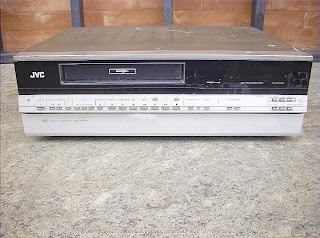JVC HR-7700EK YEAR 1980.
Wave bands VHF/UHF
Details Video-Taperecorder/-Player; Radio Control (+Remote Wire etc)
Power type and voltage Alternating Current supply (AC) / 110; 127; 220; 240 Volt
Loudspeaker - For headphones or amp.
Video Cassette Recorder HR-7700 EG - JVC - Victor Company of Japan,
Material Various materials Shape Tablemodel, low profile (big size).
Dimensions (WHD) 470 x 153 x 373 mm / 18.5 x 6 x 14.7 inch
JVC Video Cassette Recorder HR-7700 EG,
Video-Format: VHS-Standard, Frontlader, VHF/UHF.
PAL and NTSC VHS video tapes Tape speed:
PAL
SP: 23,39 mm/sec
LP: 11,7 mm/sec
NTSC
SP: 33.35 mm/sec (1 3/8 inches/s)
LP: 16.67 mm/sec (11/16 inches/s)
EP: 11.11 mm/sec (7/16 inches/s)
Tape formats
| PAL/SECAM times | NTSC times
name length/metres | SP LP | SP LP EP
======================================================
E-30 45 m 30 min 60 min 22 min 44 min 66 min
E-60 88 m 60 min 120 min 44 min 88 min 132 min
E-90 130 m 90 min 180 min 65 min 130 min 195 min
E-120 173 m 120 min 240 min 86 min 172 min 258 min
E-180 258 m 180 min 360 min 129 min 258 min 387 min
E-240 346 m 240 min 480 min 173 min 346 min 519 min
E-300 432 m 300 min 600 min 216 min 432 min 648 min
T-20 44 m 28 min 56 min 20 min 40 min 60 min
T-30 64 m 42 min 84 min 30 min 60 min 90 min
T-45 94 m 63 min 126 min 45 min 90 min 135 min
T-60 125 m 84 min 168 min 60 min 120 min 180 min
T-90 185 m 126 min 252 min 90 min 180 min 270 min
T-120 246 m 169 min 338 min 120 min 240 min 360 min
T-160 326 m 225 min 450 min 160 min 320 min 480 min
T-200 407 m 281 min 562 min 200 min 400 min 600 min
JVC - Victor Company of Japan, Ltd.; Yokohama (J)
Abbreviation: jvc
Products: Model types Others
Summary:
JVC - Victor Company of Japan, Ltd., Yokohama.
It is a leading company in the audiovisual field and has set some world wide standards like the VHS video format.
Founded: 1927
History:
Since its foundation as a manufacturer of records and phonographs in 1927 ("The Victor Talking Machine Company of Japan, Limited"), Victor Company of Japan, Ltd. (JVC) has been a long-time leader of hardware and software development in the audiovisual field.
JVC's technology has been instrumental in shaping the way society gathers and views information. Breakthroughs such as 45/45 stereo record systems, 4-channel stereo systems, 2-head VTR's and the invention of the VHS video format in 1976, have all radically impacted communications and entertainment standards, spawning new industry around the world.
JVC's commitment to "standard unification" of the VHS format has allowed JVC to deliver customer-oriented products, and has ensured that JVC's VHS video equipment has gained reliability as a life-long tool. VHS has grown with the development of W-VHS to comply with next-generation wide-screen TVs as well as D-VHS for digital technology.
Victor Company of Japan, Limited (JVC) ist ein Unternehmen mit Sitz in Yokohama, Japan, das sowohl Unterhaltungselektronik für den Heimanwender und die Unterhaltungsindustrie als auch medientechnische Geräte für semiprofessionelle und professionelle Anwendungen entwickelt und vertreibt. Es hat etwa 36.000 Angestellte (2003). Das Unternehmen wurde am 13. September 1927 als Tochtergesellschaft der US-amerikanischen Victor Talking Machine Company gegründet, löste sich aber mit Beginn des Zweiten Weltkrieges von seiner Muttergesellschaft. Anfangs befasste JVC sich mit der Herstellung von Schallplatten und deren Verbesserung, z. B. der Entwicklung des 45/45-Stereoformates. Viele markterfolgreiche Innovationen folgten und haben JVC stetig wachsen lassen. 1954 wurde JVC von Matsushita übernommen.
1976 brachte JVC den ersten VHS-Videorekorder für den Heimgebrauch mit der Modellbezeichnung HR-3300 auf den Markt. Ab 1986 entwickelte JVC ein verbessertes VHS-Format (S-VHS, erstes Modell: HR-S5000 PAL bzw. HR-S7000 NTSC) und das kleinere VHS-C-Format für tragbare Recorder und Camcorder. 1995 folgte der erste Digital-Camcorder im Taschenformat (JVC GR DV-1) und seit 2002 Plasmabildschirme. Im Bereich der Unterhaltungselektronik brachte JVC 1991 die weltweit erste Micro-HiFi-Anlage (UX-1) auf den Markt. Als europäische Ableger wurden 1977 die JVC (U.K.) Limited gegründet. In Deutschland hatte die Firma U.J.Fiszman, Frankfurt/M. den Exclusivvertrieb ab 1960-1993. Eingeschlossen in diesem Werksvertrag waren auch die Comecon-Staaten auf die 1960 in Japan keinerlei Interesse bestand . Aber Fiszman hatte den Riecher dafür .In 1978 wurde die JVC-Deutschland GmbH (seit 1993 in Friedberg) gegründet die zu ihren Frankfurter Zeiten weiter in den Gebäuden von Fiszman firmierte .. Aufgrund hoher Verluste von JVC begann Matsushita 2007 mit einem teilweisen Verkauf an Kenwood und damit einer Reduzierung seiner Firmenanteile. Am 1. Oktober 2008 wurde JVC mit Kenwood zur JVC KENWOOD Holdings zusammengeschlossen.







0 commenti:
Post a Comment
The most important thing to remember about the Comment rules is this: The determination of whether any comment is in compliance is at the sole discretion of this blog’s owner. Fair people are getting fair reply. Spam and useless crap and shitty comments / scrapers / observations goes all directly to My Private HELL without even appearing in public !!!
Requiring blog comments to obey well-defined rules does not infringe on the free speech of commenters.
Resisting the tide of post-modernity may be difficult, but I will attempt it anyway.
Your choice.........Live or DIE.
That indeed is where your liberty lies.
Note: Only a member of this blog may post a comment.